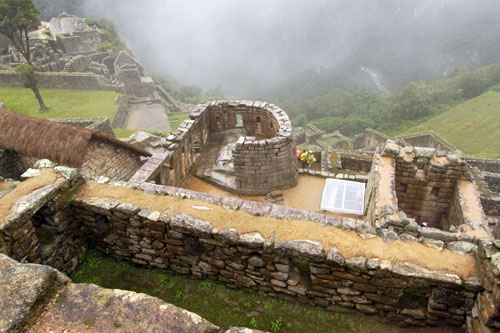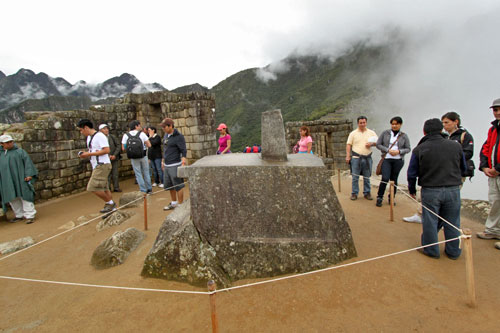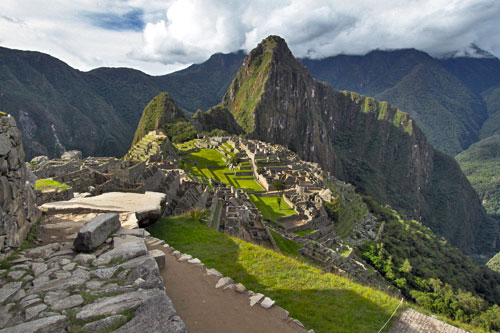The day I had dreamed about for much of my life – visiting the Lost City of the Incas – finally arrived. Twitching with excitement, I climbed out of bed and watched the cloud forest emerge from inky blackness, hoping for sunny skies. An hour later it was clear my wishes were not to be granted; the day dawned gray and rainy. Undaunted, I grabbed my umbrella and headed out to meet my private guide for the day, provided by the Inkaterra Machu Picchu Pueblo Hotel. Though I could have visited Machu Picchu on my own, for this once-in-a-lifetime experience I decided to splurge in order to learn as much as possible about one of the world’s most iconic archeological sites.
A 20-minute bus ride carried us up switchback dirt roads to the entrance, beyond which my guide turned left onto a stone staircase, bound for the top of Machu Picchu Peak. As we climbed ever higher, the famous mountaintop Citadel came into view; even shrouded in thick clouds it was a spectacular sight that took my breath away. At the top I stood next to the Guard House, the original entrance to Machu Picchu, gasping for breath in the 8,000 foot altitude and trying to grasp how and why this so called Lost City of the Incas was built. My first surprise came when I learned that Machu Picchu is not the fabled “Lost City.”

Though it was little known to the outside world prior to its rediscovery in 1911 by American historian Hiram Bingham, it has always been known to locals, most especially to the Quechua who are direct descendants of the Incas. Bingham had been searching for the city of Vilcabamba, the last Inca refuge during the Spanish conquest, when he learned about a nearby mountaintop ruin from Melchor Arteaga, a Quechua muleteer with whom he was staying. Bingham paid Arteaga one Peruvian sol – worth about 33 cents today – to lead him to the ruin we now know as Machu Picchu. Mistaking it for Vilcabamba, Bingham dubbed it the Lost City of the Incas and the name stuck, even after the real Vilcabamba was discovered some time later. Eventually the government of Peru recognized the importance of Machu Picchu and took steps to protect it however, before they could actually create the sanctuary, they had to relocate indigenous Quechua living among the ruins. Years earlier, unaware that the ruins existed, the government had deeded the entire mountaintop to three local families.

From the top of Machu Picchu Peak I descended rain-slicked stone steps to the central ruins, marveling at monolithic granite stones so perfectly fitted together that not even a piece of paper will fit between them. My guide pointed out the difference in the masonry: painstakingly polished stones were used for religious structures, while rough-hewn stones signaled structures used by commoners. Though theories abound, most now believe that Machu Picchu was a religious center, occupied primarily by priests, members of the Royal family, and the commoners who served them. Three of the 140 structures found at the Citadel: the Sun Temple, The Temple of Three Windows, and the Temple of the Condor, seem to support this theory, but to me the most fascinating features of all were the monolithic stones carved to mimic the silhouette of the mountains on the opposite side of the valley and the Intihuatana, a behemoth rectangular rock with a sundial-like protrusion on top that is believed to have been designed as an astronomic clock or calendar.

At the Intihuatana, I watched visitors reach across guard ropes to “feel” the rock. My guide explained that many people believe the rock emanates a spiritual energy and that the Inca may have considered it a portal into other dimensions. I reached over the ropes and slowly scanned the rock until, at one specific point, I felt heat and a deep throbbing in the palm of my hand. “Do you feel something?” my guide asked, explaining that he had never been able to feel anything from the rock, despite his Quechua roots. I guided his hand to the spot where I had felt the energy and showed him how to scan back and forth until he found the “heat.” I watched the recognition dawn on his face. His eyebrows shot up and a surprised look told me he had finally tapped into the power.
Can’t view the above slide show of Machu Picchu Citadel in Peru? Click here.
As we munched on box lunches the rain stopped and the sun peeked through the clouds. My guide departed shortly thereafter but by then I knew my way around, so armed with volumes of information about the history and purpose of the Citadel I once again scaled the peak for a view of Machu Picchu under sunny skies. I sat cross-legged on one of the broad agricultural terraces and watched the day’s 2,500 visitors abandon the site. By 3 p.m. I had Machu Picchu all to myself as the grassy central plaza glistened chartreuse and the ruins turned a burnished gold in the setting sun.

In the end, the wonderment of Machu Picchu may not be how or why it existed, but that it survived intact, unlike most other Inca sites that were eventually plundered or destroyed by the Spaniards. Legend says that upon learning about the advancing Spaniards, the Incas erased all signs of roads leading to Machu Picchu and abandoned it rather than allowing their most sacred of sites to fall into the hands of marauders. I am most grateful that they did.
Inkaterra Machu Picchu Pueblo Hotel kindly hosted the author’s visit to Machu Picchu, Peru. However, the receipt and acceptance of complimentary items or services will never influence the content, topics, or posts in this blog. I write the truth, the whole truth, and nothing but the truth. In this case, I highly recommend Inkaterra, not only for their excellent facilities, services, and staff, but also for their devotion to conservation. The special Machu Picchu tour I booked through the hotel included a very informed guide, bus ticket to and from the ruins, entrance ticket and box lunch, all for $150.

Beautiful pictures! When I visited Machu Picchu last year in June, it was also foggy in the morning and cleared up afterwards and it made my experience even better. I felt like I was in a mysterious city while it was covered by the fog.
I only had two days to visit the city of the Incas so I took the train to get to Aguas Calientes and back. Next time (hopefully soon) I’ll take more time and try to do the Inca Trail to Machu Picchu to have a more complete experience <3
Hi Lorena: Thanks so much for your comment. It’s without a doubt the most spectacular place I’ve visited in more than 100 countries. Like you, I hope to return one day.
Those are some great pics! During what month did you go there?
I visited in December, Matthew. It was rainy and fog-covered in the morning, but cleared up in the afternoon, which I understood to be the norm.
It’s really wonderful Machu Picchu tours, is a beautiful city .. really have to visit.
One of the most spiritual and inspiring places I’ve ever visited. While the various temples and guided tour was interesting, the relaxed peace sitting in the courtyard under a tree enjoying the quiet afternoon meander past will stay with me forever. Incidently I shared the tour with a young Australian archaeologist who specialised in Aztec civilisations and who offered some unique insights into the tour but that is a story for another day.
Peru is amazing ,and machu picchu is a magic aplace where you have the feeling of being indiana jones living a great adventure! i live in ecuador, so every chance i get i arrange a vacation rentals there and visit Peru . Few people like this country as much i do , i don’t know why ! jajajaja
Oh, mountains are very nice, just like in Armenia 🙂
it looks like great wall of china… i like to visit there
Awesome photos and interesting information given here. I always keep in touch with your blog and going
to bookmark also. Thanks.
I have also always wanted to see Macchu Pichu. But I have to ask — did you think it was amazing, even given how many tourists were there? I mean, it would be hypocritical of me to diss tourists, as I would be one, but did it take away at all from the “Lost City” feeling?
Epic: There were lots of people there in the morning, but most leave by 2 pm and I had the place all to myself. It was magical.
SOOOOO happy that you made it there and had such a perfect day. Your pictures are amazing! Very cool that you stayed late and caught the afternoon sun – a great idea!
Barbara, l have been reading your posts for some time. Your story-telling brings your travels alive. I feel like I am along with you. Your photography enhances my armchair experience. Did you go to school for photography, where, and how long have been shooting travel photography? What kind of equipment do you carry? Camera? You are an inspiration to me and I suspect all women traveling solo! Thank you for your work! Joan Kosmac
Hi Joan: Thank you SO much – you have no idea how much your comment means to me. I am completely self-taught in photography and have been shooting since I was about 11 years old. I currently use a Canon T3i, however it’s not the body that matters, it’s the lenses. My walk-around is a 10-22mm F/3.5-4.5, and I also carry a 70-300mm F/4.5 telephoto as well as a 50mm f/1.4. All are exceptionally crisp lenses and I can highly recommend them. All the best.
Must have been amazing to have the place to yourself!
It definitely was Nate! I couldn’t imagine how everyone could spend so little time there.
I think it was the “lost” city due to all of the fog and mist. What time does it all burn off?
Hi Lane and Juliet:
The day I was there, the fog started burning off around 1 p.m., though I have heard that some days it never burns off, so I consider myself very lucky.